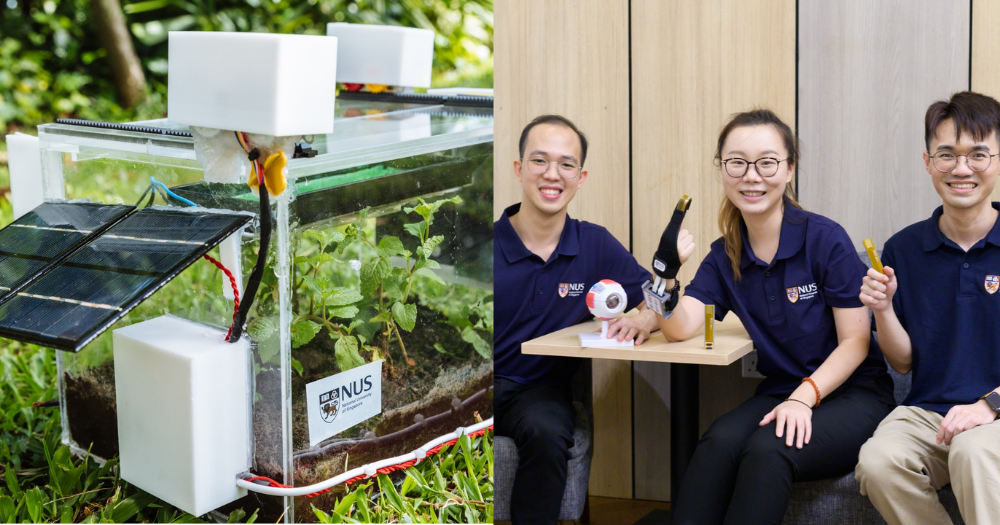Follow us on Telegram for the latest updates: https://t.me/mothershipsg
Picture this: you are fresh out of Junior College, polytechnic or an International Baccalaureate Programme, and you are surveying courses to pursue your degree.
There are many factors to consider in choosing your degree: Your interests, eligibility, strengths, and possible careers in the future.
Perhaps one of the considerations that you might want to look into is the achievements of the alumni, research staff, as well as academic members of the department.
National University of Singapore’s (NUS) Department of Materials Science and Engineering (MSE) has an extensive list of interesting inventions and achievements that might prove useful in changing the world in the future.
Harvesting water from air for farming
Students and faculty members from NUS MSE are not afraid to get their hands dirty to find solutions creatively.
For instance, converting water from thin air.
Yes, apparently you can do that with a newly developed copper-based hydrogel created by Tan Swee Ching, an Assistant Professor from the department.
Dubbed as the “SmartFarm”, the hydrogel has the ability to absorb moisture from the air and convert it into water.
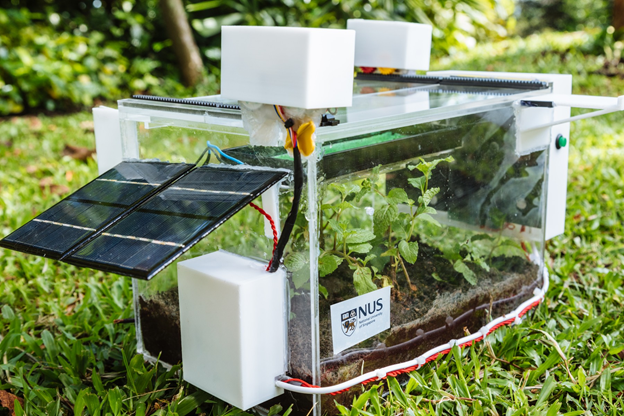
The water is then used for a self-sustaining irrigation system without manual intervention.
The SmartFarm is solar-powered, and the hydrogel is used to absorb moisture from the air at night when the relative humidity is higher.
The water is then released in the morning when it’s being exposed to sunlight for irrigation.
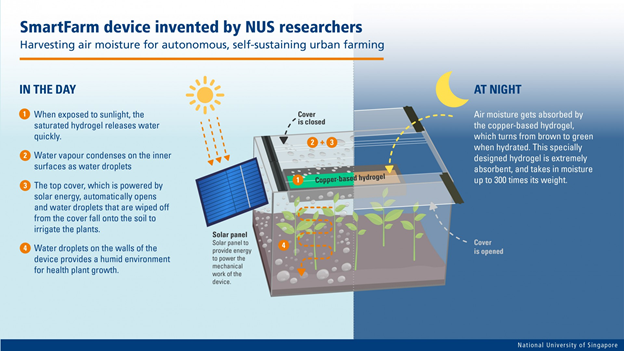
One gramme of the hydrogel releases about 2.24 grammes of water in an hour.
Not only could the hydrogel convert water from thin air, but the quality of the water is deemed to be drinkable under the World Health Organisation’s standard.
This invention is not only applicable on Earth.
The hydrogel was also tested in Hawaii’s Space Exploration Analogue and Simulation (HI-SEAS), a remote facility in Hawaii’s Mauna Loa volcano, designed to simulate long-duration missions to the moon and Mars.
Tan used the hydrogel to control the humidity in small experimental greenhouses to sustain crops of edible microgreen sunflower plants and upland cress for astronauts on missions.
The experiments showed that the hydrogels offer a potential low cost, low weight and low energy solution to growing crops in self-sustaining farms in space.
Bringing HOPES to glaucoma patients
Other than trying to solve real-world problems, NUS MSE also has inventions that are human-centric and aim to ease the burden for those in need.
Yu Kelu, a graduate student in NUS MSE, came up with an award-winning invention after seeing how her father had to endure long hours at a hospital just to get his eyes checked for glaucoma.
Together with Benjamin Tee, an Associate Professor from the department, Yu and her team managed to invent a solution that allows patients to self-test from the comfort of their homes.
Their invention won the James Dyson Award in 2021 – the first time a team from Singapore won the award since it started 17 years ago.
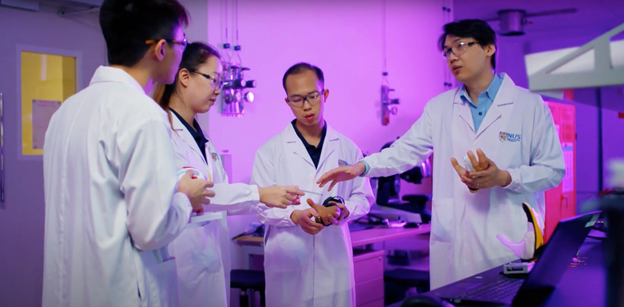
The Home Eye Pressure E-skin Sensor (HOPES) is designed for safe, accurate, pain-free and low-cost intraocular pressure (IOP) monitoring at home.
IOP refers to the fluid pressure of the eye.
Traditionally, measuring the IOP can be quite daunting.
The patients’ eyes are anesthetised using numbing drops, and a small amount of non-toxic dye is then placed in the eye.
After which, an ophthalmologist will position the patient’s head into a slit lamp and a small tip will gently touch the surface of the eye and the measurement of the pressure is taken.
With HOPES, this intimidating procedure could soon be a thing of the past.
It uses a combination of electronic skin (e-skin) sensor technology and artificial intelligence (AI) to measure IOP.
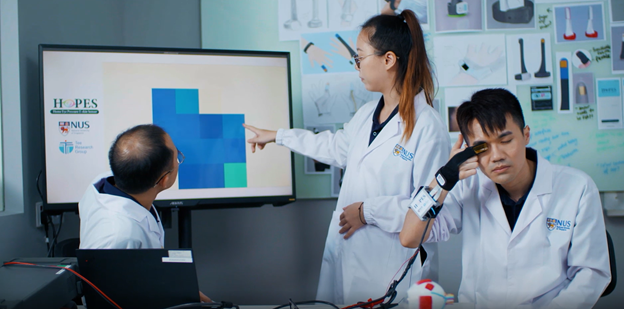
The device consists of a glove with sensors in the fingertips that are linked to a mobile application.
Users only need to touch their eyelids with the glove on.
The sensors will then capture the dynamic pressure information of the user’s eye and process it by machine learning algorithms to compute the eye pressure.
Plant-derived biopolymer for surgical adhesions
Plant-based diets are all the hype now but this invention has nothing to do with food or diet.
In medical terms, adhesions are fibrinous bands of internal scar tissue that cause internal tissues and organs that are typically separated to stick together.
More than 90 per cent of patients develop peritoneal adhesions following their initial laparotomy, a surgical procedure that makes small incisions through the abdominal walls.
As a result, they might suffer from small bowel obstruction, infertility and pain in their pelvic area.
An academic from NUS MSE managed to find a way to overcome this issue by using a plant-based biopolymer.
Ng Wei-Beng, an Associate Professor in the department who is also an alumni of the department, has identified anti-fibrinolytic characteristics in a unique plant-derived biopolymer.
Ng is also the CEO and founder of Sporogenics Pte Ltd.
The naturally derived biopolymer contains bioactive ingredients which can attenuate the cellular mechanism and signalling pathway of fibrogenesis to treat post-surgical adhesions.

It can be harvested and processed into a film (for open surgery) or spray-on gel (for keyhole surgery).
Pre-clinical studies of the biopolymer in animals showed promising results.
It greatly reduces postsurgical adhesions by over 90 per cent.
They are planning to begin their first human clinical trials in 2022.
Nobel Prize-winning physicist joins NUS MSE
Students and researchers of NUS MSE can also interact and learn from a Nobel Prize winner, which is something that many current students and faculty appreciate.
Konstantin Novoselov joined NUS MSE as Distinguished Professor of Material Science and Engineering in April 2019.
He was also knighted by the Queen of England.
Novoselov is the first Nobel Prize winner to join NUS.
MSE is the only department in the College of Design and Engineering in NUS with a Nobel Prize winner.
Novoselov was the youngest Nobel Laureate in Physics since 1971, and the youngest overall since 1992.
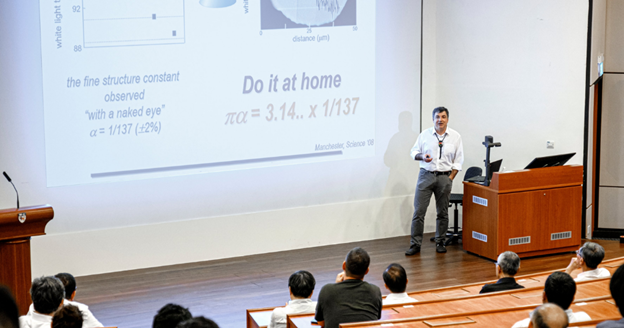
Novoselov and Professor Andre Geim were awarded the Nobel Prize in 2010 for their discovery of the two-dimensional material, graphene.
Graphene is considered one of the most exciting materials in technological research.
It is being tested in desalination filters to produce clean potable water, in batteries, next-generation LED bulbs and solar cells.
In NUS MSE, Novoselov is leading a research group focusing on advanced materials.
The group aims to discover interesting combinations of materials that can behave as intelligent sensors and micro computing devices.
Lab tours and virtual roadshows
From all the inventions and discoveries listed, NUS MSE has a good blend of science (physics, chemistry, biomedical) and engineering.
The top-ranked department in global ranking offers a multidisciplinary programme that incorporates new elements such as innovation, entrepreneurship, data science, artificial intelligence and intellectual property for materials innovation into its curriculum.
In that regard, NUS MSE is suitable for students interested in the sciences and are eager to apply that knowledge to real-world applications.
Graduates from the programme can have multiple possible career opportunities as the curriculum prepares them for careers in research, industry and even entrepreneurship.
If you would like to know more about NUS MSE, you can leave your details on its admission microsite.
You will receive personalised updates on the programme via your email.
There is also a chance for you to tour NUS MSE’s labs and learn more about the programme and the research that they are pursuing.
You will also get to attend virtual roadshows on trending topics regarding MSE.
Follow and listen to our podcast here
Top images courtesy of NUS MSE.
This sponsored article from the NUS Department of Materials Science and Engineering made the writer read scientific research papers.
If you like what you read, follow us on Facebook, Instagram, Twitter and Telegram to get the latest updates.
